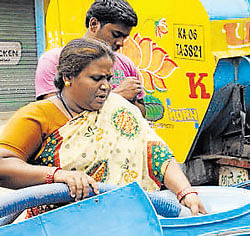Water woes for Bangaloreans will continue with fresh government data demonstrating that the current level of water supply in India's IT capital is almost four thousand million cubic metre short of the requirement, exposing 22 lakh people to water scarcity every year.

The shortfall is in the prevailing situation. If City aquifers become barren due to over-exploitation, an additional 24 lakh will have a tough time getting their daily water supply from civic authorities, geologists have forewarned. The warning is based on water data collected by the Karnataka government's mines and geology department from 10 deep wells in Bangalore, between April and December 2011.
“Against an annual demand of 48,600 hectare metre of water, only 37,374 ha mt is now being supplied from surface and ground water resources. The shortage of nearly 11,226 ha mt (about 4 TMC, considering 2831.7 ha mt equals to one TMC) means nearly 22 lakh people face water scarcity,” the researchers reported in April 25 issue of “Current Science”.
The City administration measured ground water level for three decades since 1973 before the practice was discontinued around 2000. Though a few shallow wells were dug, that service too was interrupted.
The measurement restarted in 2010 when 12 wells with a depth up to 150 mt were dug all over the City. Ten of them were fitted with a digital water level meter. Automated measurements were carried out at Doddakannalli, Hebbal, HSR Lay Out, Kallkere, Laggere, Mahadevapura, Pattanageri, Sadashivnagar, Yelahanka and Bagalagunte.
There is an estimated 3.12 lakh borewells, among private owners (1,05,500 wells) registered with Bangalore Water Supply and Sewerage Board ) and two lakh unregistered private bore wells extract more than 9,161 ha m ground water every year for domestic, commercial and industrial needs. One ha m equals to 10,000 cubic metres.
“Pressure on ground water is increasing with population rise,” G V Hedge, lead author of the paper from the mines and geology department, has said.
Parts of the City where the supply from the Cauvery river is adequate do not face problems of depleting ground water reserve.
“Groundwater is now not a sustainable resource. It needs to be considered only as a standby resource to be used during scarcity or drought. There should not be exploitation of ground water resources beyond 60 per cent of annual ground water recharge,” Hegde has said.
The scientists suggested conservation of annual storm water discharge (17,040 ha mt per year or almost six TMC), which can meet the requirement of 23 lakh people. A second suggestion is to recycle and treat the sewerage water to bring its quality on a par with drinking water and reuse it subsequently.
In an unconnected report that reviewed the sewage treatment facilities in Bangalore, the Comptroller and Auditor-General showed that the Garden City could treat only one-tenth of the sewage it generates before discharging the sewage into rivers.
The average sewage generated in Bangalore is 1,200 million litres a day and sewage treatment plant capacity available is only 463 mld. But in reality only 120 mld sewage is treated and 1,080 mld untreated sewage ended up polluting Pennar and Cauvery rivers, CAG said, in its special audit on water pollution in India tabled in Parliament last year.